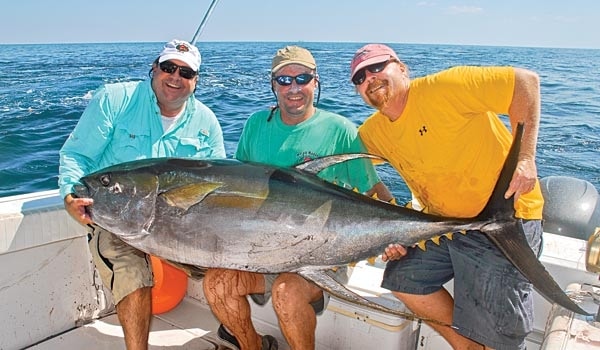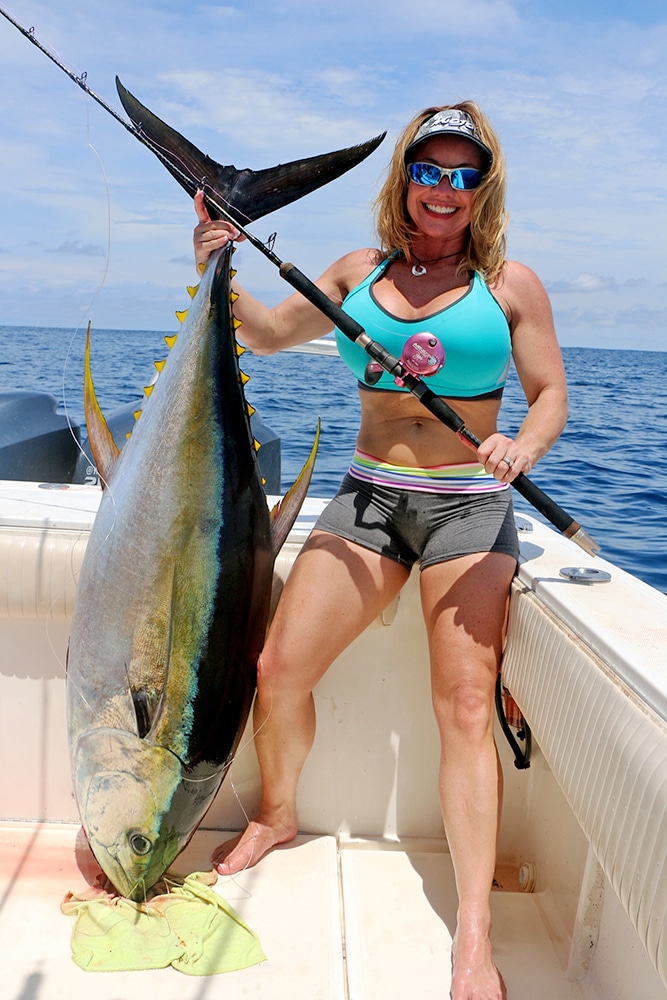
I had just cracked open a drink when the fish came up. I set the brew on the bait tank, buckled in as a tuna slurped the bait, lifted the 80-wide Tiagra out of the holder and went to work. My beer was still ice cold when we gaffed the 192-pound yellowfin.
That short, effective fight depended on the 200-pound Seaguar fluorocarbon leader, 40 pounds of drag and a true winch of a reel. But the gear doesn’t matter if you don’t use it right, and that means using its power to hurt tuna instead of yourself. I’m a big guy and I’ve caught hundreds of tuna over 100 pounds, but size doesn’t matter. I’ve seen little old ladies use the right techniques and catch fish much bigger than I ever have. My friend caught a 300-pound yellowfin on stand-up gear when he was 78.
Use a Harness and Pad to Fight Big Tuna
The key is a good harness and pad, and the ability to use it. One of my favorites is from AFTCO, designed by Greg Stotesbury. Stotesbury’s stand-up experience, like mine, is grounded in the San Diego long-range fleet. No offense, East Coasters, but most of you don’t know how to use a harness. Here’s how it works.
If you learn anything here it should be this: When fighting a fish, you should feel all the force transferred by the harness from the point of your hips down. You want the belt around your butt, not the small of your back.
In preparation, wear the harness before the bite. Wait until the fish is solidly hooked and pulling drag before you put the rod in the belt and clip in. Many fish are lost early when folks fumble with their gear instead of fighting the fish. Once you are fastened to the fish, attitude is everything. Stay calm and relaxed. Don’t let adrenaline and bad form hurt you.
How to Fight Tuna in a Fishing Harness

Proper form means good posture: Put your left hand on the reel to guide the line, with your right hand on the handle. Keep your back straight, and bend your knees enough to distribute the pressure across the tops of your quads and your backside.
Modern composite rods do all the work when kept at right angles to the rail. When the tip comes up, wind it back down. If you can’t turn the handle, switch the reel to low speed. Can’t keep up? Go to high speed. Don’t impart wild pumping motions. Instead, focus on the rod tip. Call out deep color when you see it, and wind the fish up to the gaff.
Safety Tips for Fighting Big Tunas
A couple of safety notes should be added. Every tuna is an individual, and where the hook ends up influences how the fish acts. Yellowfin tuna hooked in the upper jaw by the snout are notoriously squirrelly. You have to be prepared to react to the predictable and unpredictable, and that often means getting out of the harness.
Use S-hooks instead of clips to attach the harness to the reel lugs so you can get out quickly if necessary. And remember to back off the drag (gradually, don’t dump it into free-spool) when you need to get the rod out of the gimbal pad for maneuvers such as keeping the line out of the props.
How to Gain Line When Fighting Big Tuna

When you sit back and put on a lot of pressure, a fish will often run out high in the water column. Enjoy the fact that now the fish is on the losing end of the energy equation. This is the only time you can take a breather. When the fish stops, bear down on it. Try to get a turn on the handle, going to low gear if necessary.
Tuna will often respond to the pressure by diving in the direction of the boat, which provides you the opportunity to win back a bunch of line with no more effort than turning the handle. Be ready to go into high gear when the fish sounds, and take that easy line.
Once the fish goes into the final stage of the fight — straight up and down — it’s time to really put on the heat. Stay in one spot and keep the rod straight out from the rail. The tuna’s tail beats are reflected in the pumps of the rod tip as the fish circles — the more pressure, the tighter the circle. The tip of the rod will come up as the fish leaves the inside (closest to the boat) of the circle. That’s when you get those precious feet of line with several quick turns of the handle to bring the tip back down and keep the fish moving up. Don’t waste energy by stubbornly trying to turn the handle when you stop gaining line.
Most important, stay relaxed so you reserve the burst of energy and sharpness of mind that is usually called for at the end of the fight. Sometimes, a truly mean fish will say to hell with this and bust a big move. The telltale is an irritated shake of the head. You have to be ready to respond and follow. It’s usually over soon after that — one way or another.








